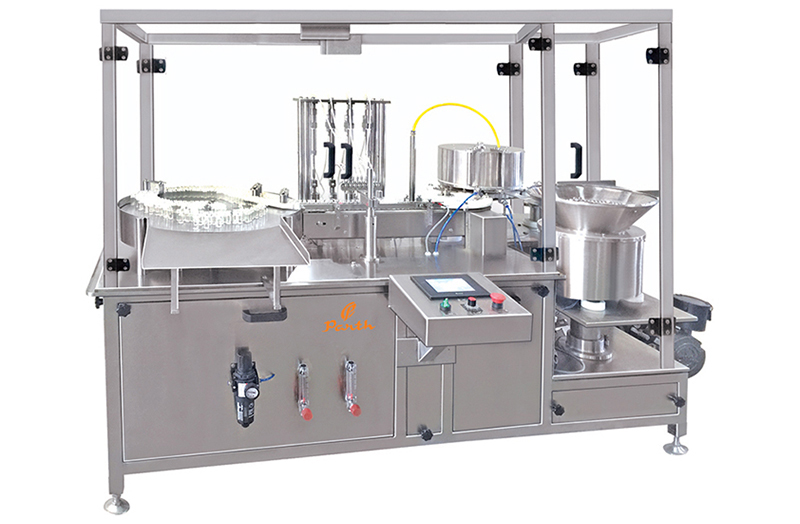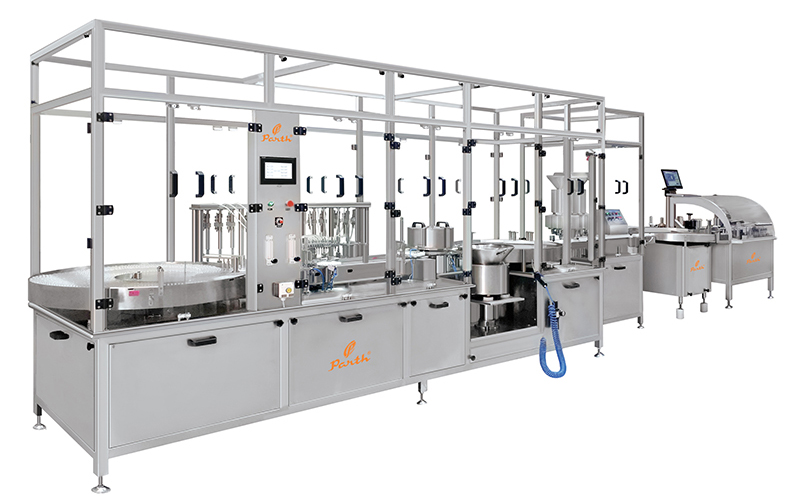In pharmaceutical manufacturing, every second counts. As demand for injectable therapies grows, the need for high-performance, low-maintenance filling solutions becomes more urgent. Modern production lines must balance speed with accuracy, sterility with reliability. At the heart of this transformation is the liquid injection filling machine - a cornerstone technology that can define throughput, downtime and ultimately, profitability.
This article explores how a high-capacity injectable liquid filling line, built with intelligent automation and precision-engineered components, can dramatically minimize downtime and maximize output for pharmaceutical companies. It also looks at how such machines integrate into complete production ecosystems, enabling faster, cleaner and more efficient vial processing from start to finish.
The Role of Liquid Injection Filling Machines
A liquid injection filling machine is engineered to fill Only Glass (Tubular and Moulded) vials with sterile liquids—typically antibiotics, biologics, or other parenteral drugs—under aseptic conditions. These machines are usually a part of a broader injectable liquid vial filling line, which may also include washing, drying, stoppering, sealing, labeling, inspection, and packaging modules. We can provide machinery that complies with pharma norms and is EU-GMP and GMP certified.
Core goals of these machines include:
- Precision dosing
- Minimizing product wastage
- Maintaining aseptic environments
- High-speed performance without sacrificing accuracy
But even with the best technology, performance bottlenecks can occur. These bottlenecks often result from manual intervention, improper synchronization, mechanical wear or inadequate changeover protocols. High-capacity filling machines are designed specifically to address these limitations - through robust build quality, integrated automation and modular system architecture.
Built for Throughput: How High-Capacity Systems Enhance Productivity
The key metric in any pharmaceutical operation is output per minute. High-capacity liquid injection filling machines are optimized to achieve maximum throughput by leveraging:
- Servo-driven filling systems for precise and rapid dosing
- Multi-head filling stations
- Continuous motion conveyors that reduce transfer delays
- Synchronized stoppering units that seal vials immediately after filling
These machines are often designed to operate at speeds exceeding 350 vials per minute, depending on the configuration and vial volume. This makes them ideal for batch production and large-scale commercial manufacturing.
By streamlining the dosing-to-sealing process within a unified motion sequence, these systems can significantly reduce idle time and eliminate unnecessary human interaction on the line.
Reducing Downtime: Maintenance-Friendly Engineering
Downtime isn’t just about machine failure - it includes cleaning, changeover, calibration and even minor jams. High-efficiency injectable liquid filler machines focus on minimizing each of these delays.
Design Considerations That Reduce Downtime:
- Modular design with tool-less disassembly for fast part changes and cleaning
- Self-lubricating components and minimal wear mechanisms
- Easy-access panels and maintenance hatches
- Programmable touchscreens that allow quick parameter updates and batch recalls
Many machines also feature automatic fault detection and diagnostics, allowing operators to identify and resolve issues without full line stoppage. This keeps production moving and avoids costly unscheduled maintenance.
Enhancing Fill Accuracy and Volume Control
Accuracy is critical in injectable filling. Overfilling results in product loss, while underfilling leads to rejections. High-capacity liquid injection filling machines achieve superior control through:
- Servo motor-driven peristaltic or piston pumps
- Real-time flow and fill volume monitoring
- Integrated sensors that detect fill deviations instantly
- Auto-correction algorithms that recalibrate after detecting irregularities
Such features help maintain volumetric tolerances within tight margins - even for high-speed filling of viscous or temperature-sensitive formulations.
Additionally, dosing is synchronized with vial movement to prevent foam generation and turbulence, which are common issues in fast-paced injectable production.
Seamless Integration with Stoppering and Sealing Units
A fully automated injectable liquid filling line doesn't stop at dosing. It continues into precise stoppering and sealing - two stages that are tightly interlinked with fill volume and vial pressure.
Integrated Features:
- Vacuum-assisted rubber stoppering to minimize vapor pressure shifts
- Mechanical or servo-driven sealing heads for uniform crimping
- Star-wheel or belt-driven vial indexing for smooth vial handover between stages
Synchronizing these functions not only ensures faster operation but also reduces the likelihood of sealing errors or stopper misalignment - two common causes of line rejection.
Quality-Focused Design: Inline Inspection & Reject Mechanisms


High-speed production should never compromise quality. That’s why injectable liquid filler machines often integrate inspection systems into their architecture. These may include:
- Visual inspection cameras for fill level and stopper position
- Weight check modules to verify dose accuracy
- Reject stations that automatically divert non-compliant vials
Such built-in safeguards ensure that only vials meeting fill and closure standards proceed to the next stage-reducing risk, rework and operator burden.
Extended Integration Across the Injectable Liquid Filling Line
Beyond filling and stoppering, today’s production environments benefit from full-line automation. A robust liquid injection filling line can include:
- Rotary or linear vial washing machines
- Drying and sterilizing tunnels
- Liquid Filling & Rubber stoppering machine
- Cap sealing machines
- Roller inspection conveyors
- Labeling and carton packing stations
When integrated into a unified system, these components can be managed via a central interface. The result is a seamless, high-throughput, end-to-end solution that cuts manual handling to a minimum while keeping output rates consistently high.
Scalability and Customization: One Machine, Many Possibilities
The best high-capacity systems are not one-size-fits-all. Instead, they offer scalability and customization. Manufacturers may choose from a range of options, including:
- Filling systems optimized for different vial sizes
- Special nozzle designs for foamy or viscous liquids
- Modular change parts for different closure types
- Customized sealing torque based on vial material
This flexibility is particularly useful in contract manufacturing environments, where product lines and container types may change frequently.


Automation, Usability and Control
Modern injectable liquid filler machines come equipped with intuitive, touchscreen-controlled HMIs. Operators can:
- Load product-specific recipes
- Monitor filling statistics in real-time
- Run diagnostic checks or simulate test batches
- View maintenance schedules and part replacement alerts
These interfaces not only simplify control but also reduce training time, operator fatigue and the potential for error - especially in multi-shift or multilingual environments.
Conclusion
The pharmaceutical industry is under constant pressure to produce more, faster - without sacrificing safety or accuracy. High-capacity liquid injection filling machines offer a powerful solution to this challenge, combining speed, precision and minimal downtime in a compact, intelligent package.
From robust engineering and servo-driven controls to seamless integration with stoppering, inspection and packaging, these machines are designed to support maximum output with minimum disruption.
Whether you're scaling a new product or upgrading an existing line, investing in a high-performance injectable liquid filler machine isn’t just a matter of machinery - it’s a commitment to operational excellence.
FAQs About Liquid Injection Filling Machines
Liquid injection filling machines are designed to fill vials with sterile liquids, such as antibiotics and biologics, under aseptic conditions.
These machines increase output by using servo-driven systems, multi-head filling stations and continuous motion conveyors to streamline the filling and sealing process.
High-efficiency machines are designed for easy maintenance, with tool-less disassembly, self-lubricating components and automated fault detection.
Precision is achieved through servo motor-driven pumps, real-time flow monitoring and automatic recalibration for any detected filling deviations.
Yes, these machines offer scalability and customization, including options for different vial sizes, nozzle designs and closure types.









